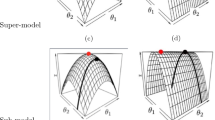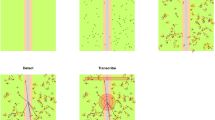Abstract
To study population dynamics, ecologists and wildlife biologists typically use relative abundance data, which may be subject to temporal preferential sampling. Temporal preferential sampling occurs when the times at which observations are made and the latent process of interest are conditionally dependent. To account for preferential sampling, we specify a Bayesian hierarchical abundance model that considers the dependence between observation times and the ecological process of interest. The proposed model improves relative abundance estimates during periods of infrequent observation and accounts for temporal preferential sampling in discrete time. Additionally, our model facilitates posterior inference for population growth rates and mechanistic phenometrics. We apply our model to analyze both simulated data and mosquito count data collected by the National Ecological Observatory Network. In the second case study, we characterize the population growth rate and relative abundance of several mosquito species in the Aedes genus. Supplementary materials accompanying this paper appear on-line.





Similar content being viewed by others
References
Albert JH, Chib S (1993) Bayesian analysis of binary and polychotomous response data. J Am Stat Assoc 88(422):669–679
Aukema BH, Carroll AL, Zheng Y, Zhu J, Raffa KF, Dan Moore R, Stahl K, Taylor SW (2008) Movement of outbreak populations of mountain pine beetle: influences of spatiotemporal patterns and climate. Ecography 31(3):348–358
Bewick S, Cantrell RS, Cosner C, Fagan WF (2016) How resource phenology affects consumer population dynamics. Am Nat 187(2):151–166
Bezanson J, Edelman A, Karpinski S, Shah VB (2017) Julia: a fresh approach to numerical computing. SIAM Rev 59(1):65–98
Bradley JR, Holan SH, Wikle CK (2018) Computationally efficient multivariate spatio-temporal models for high-dimensional count-valued data (with discussion). Bayesian Anal 13(1):253–310
Chi G, Zhu J (2008) Spatial regression models for demographic analysis. Popul Res Policy Rev 27(1):17–42
Crans WJ (2004) A classification system for mosquito life cycles: life cycle types for mosquitoes of the northeastern United States. J Vector Ecol 29:1–10
Demidova AV, Druzhinina OV, Masina ON, Petrov AA (2021) Synthesis and computer study of population dynamics controlled models using methods of numerical optimization, stochastization and machine learning. Mathematics 24:3303
Dennis B, Ponciano JM, Lele SR, Taper ML, Staples DF (2006) Estimating density dependence, process noise, and observation error. Ecol Monogr 76(3):323–341
Field EN, Tokarz RE, Smith RC (2019) Satellite imaging and long-term mosquito surveillance implicate the influence of rapid urbanization on Culex vector populations. Insects 10(9):269
Forrest J, Miller-Rushing AJ (2010) Toward a synthetic understanding of the role of phenology in ecology and evolution. Philos Trans R Soc B Biol Sci 365(1555):3101–3112
Gelfand AE, Smith AF (1990) Sampling-based approaches to calculating marginal densities. J Am Stat Assoc 85(410):398–409
Gitzen RA, Millspaugh JJ, Cooper AB, Licht DS (2012) Design and analysis of long-term ecological monitoring studies. Cambridge University Press, Cambridge
Hoekman D, Springer YP, Gibson C, Barker C, Barrera R, Blackmore M, Bradshaw W, Foley D, Ginsberg H, Hayden M, Holzapfel CM, Juliano SA, Kramer LD, LaDeau SL, Livdahl TP, Moore CG, Nasci RS, Reisen WK, Savage HM (2016) Design for mosquito abundance, diversity, and phenology sampling within the National Ecological Observatory Network. Ecosphere 7(5):e01320
Hooten MB, Hefley TJ (2019) Bringing Bayesian models to life. CRC Press, Boca Raton
Hooten MB, Johnson DS, Brost BM (2021) Making recursive Bayesian inference accessible. Am Stat 75(2):185–194
Jones CA, Daehler CC (2018) Herbarium specimens can reveal impacts of climate change on plant phenology: a review of methods and applications. PeerJ 6:e4576
Karcher MD, Palacios JA, Bedford T, Suchard MA, Minin VN (2016) Quantifying and mitigating the effect of preferential sampling on phylodynamic inference. PLoS Comput Biol 12(3):e1004789
Kéry M (2018) Identifiability in n-mixture models: a large-scale screening test with bird data. Ecology 99(2):281–288
Kéry M, Schmidt B (2008) Imperfect detection and its consequences for monitoring for conservation. Community Ecol 9(2):207–216
Knape J, de Valpine P (2012) Are patterns of density dependence in the global population dynamics database driven by uncertainty about population abundance? Ecol Lett 15(1):17–23
Koen C (2006) The Nyquist frequency for irregularly spaced time-series: a calculation formula. Mon Not R Astron Soc 371(3):1390–1394
McCulloch RE, Tsay RS (1994) Bayesian inference of trend and difference-stationarity. Economet Theor 10(3–4):596–608
Monteiro AAFO, Menezes R, Silva ME (2019) Modelling preferential sampling in time. Sociedad de Estadística e Investigación Operativa (SEIO)
Monteiro AAFO, Menezes R, Silva ME (2020) Modelling irregularly spaced time series under preferential sampling. Instituto Nacional de Estatística (INE)
Mouillot D, Lepretre A (1999) A comparison of species diversity estimators. Res Popul Ecol 41(2):203–215
National Ecological Observatory Network (2021) Mosquitoes sampled from CO\(_2\) traps (dp1.10043.001), release-2021. https://data.neonscience.org
Neteler M, Roiz D, Rocchini D, Castellani C, Rizzoli A (2011) Terra and Aqua satellites track tiger mosquito invasion: modelling the potential distribution of Aedes albopictus in north-eastern Italy. Int J Health Geogr 10(1):1–14
Nugent J (2018) iNaturalist. Sci Scope 41(7):12–13
Potts JM, Elith J (2006) Comparing species abundance models. Ecol Model 199(2):153–163
PRISM Climate Group (2019) PRISM gridded climate data. https://prism.oregonstate.edu
Ross BE, Hooten MB, DeVink J-M, Koons DN (2015) Combined effects of climate, predation, and density dependence on greater and lesser scaup population dynamics. Ecol Appl 25(6):1606–1617
Royama T (2012) Analytical population dynamics, vol 10. Springer Science & Business Media, Berlin
Royle JA (2004) N-mixture models for estimating population size from spatially replicated counts. Biometrics 60(1):108–115
Royle JA, Dorazio RM (2008) Hierarchical modeling and inference in ecology: the analysis of data from populations, metapopulations and communities. Elsevier, Amsterdam
Shumway RH, Stoffer DS (2000) Time series analysis and its applications, vol 3. Springer, Berlin
Sullivan BL, Aycrigg JL, Barry JH, Bonney RE, Bruns N, Cooper CB, Damoulas T, Dhondt AA, Dietterich T, Farnsworth A et al (2014) The eBird enterprise: an integrated approach to development and application of citizen science. Biol Conserv 169:31–40
Suwanmanee S, Luplertlop N (2017) Dengue and Zika viruses: lessons learned from the similarities between these Aedes mosquito-vectored arboviruses. J Microbiol 55(2):81–89
Tang B, Clark JS, Gelfand AE (2021) Modeling spatially biased citizen science effort through the eBird database. Environ Ecol Stat 28(3):609–630
Trexler JC, Travis J (1993) Nontraditional regression analyses. Ecology 74(6):1629–1637
Tripuraneni N, Gu SS, Ge H, Ghahramani Z (2015) Particle Gibbs for infinite hidden Markov models. Adv Neural Inf Process Syst 28
Turchin P (2013) Complex population dynamics. Princeton University Press, Princeton
Usher MB (1979) Markovian approaches to ecological succession. J Anim Ecol 48:413–426
Watson J (2021) A perceptron for detecting the preferential sampling of locations and times chosen to monitor a spatio-temporal process. Spat Stat 43:100500
Wikle CK, Hooten MB (2010) A general science-based framework for dynamical spatio-temporal models. Test 19(3):417–451
Williams PJ, Hooten MB, Womble JN, Esslinger GG, Bower MR (2018) Monitoring dynamic spatio-temporal ecological processes optimally. Ecology 99(3):524–535
Zachmann LJ, Borgman EM, Witwicki DL, Swan MC, McIntyre C, Hobbs NT (2022) Bayesian models for analysis of inventory and monitoring data with non-ignorable missingness. J Agric Biol Environ Stat 27(1):125–148
Acknowledgements
This research was supported by the National Science Foundation (NSF) Graduate Research Fellowship Program and was conducted as part of the “Forecasting Mosquito Phenology in a Shifting Climate: Synthesizing Continental-scale Monitoring Data” Working Group, which is supported by the John Wesley Powell Center for Analysis and Synthesis and funded by the U.S. Geological Survey. Data were collected by the National Ecological Observatory Network (NEON) and the Oregon State PRISM Climate Group. NEON is a program sponsored by the NSF and operated under cooperative agreement by Battelle. This material is based in part upon work supported by the NSF through the NEON Program. Any use of trade, firm, or product names is for descriptive purposes only and does not imply endorsement by the U.S. Government.
Author information
Authors and Affiliations
Corresponding author
Ethics declarations
Data Availability
The datasets analyzed during this study are publicly available from the National Ecological Observatory Network (DOI: dp1.10043.001) and PRISM climate group (https://prism.oregonstate.edu/). The code and data used for the case studies can be found at https://github.com/michaelschwob/DPMwTPS.
Additional information
Publisher's Note
Springer Nature remains neutral with regard to jurisdictional claims in published maps and institutional affiliations.
Supplementary Information
Below is the link to the electronic supplementary material.
Rights and permissions
Springer Nature or its licensor (e.g. a society or other partner) holds exclusive rights to this article under a publishing agreement with the author(s) or other rightsholder(s); author self-archiving of the accepted manuscript version of this article is solely governed by the terms of such publishing agreement and applicable law.
About this article
Cite this article
Schwob, M.R., Hooten, M.B. & McDevitt-Galles, T. Dynamic Population Models with Temporal Preferential Sampling to Infer Phenology. JABES 28, 774–791 (2023). https://doi.org/10.1007/s13253-023-00552-3
Received:
Revised:
Accepted:
Published:
Issue Date:
DOI: https://doi.org/10.1007/s13253-023-00552-3




